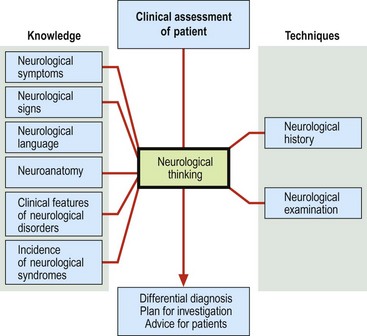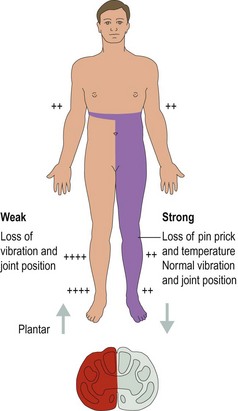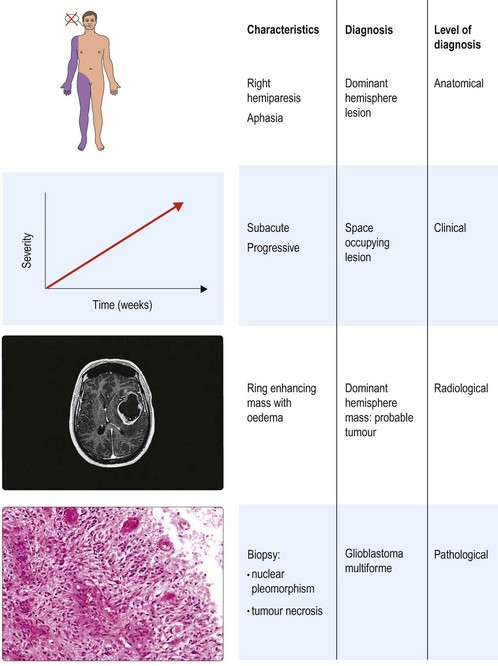Neurological thinking
How does an experienced clinical neurologist come to a clinical diagnosis? Considering how this is done helps to appreciate the knowledge and skills that are needed and to understand how they are applied.
The process of diagnosis involves:
 Background knowledge of neurological symptoms and signs, the clinical features of neurological syndromes and diseases, neuroanatomy and an appreciation of the incidence of different neurological syndromes.
Background knowledge of neurological symptoms and signs, the clinical features of neurological syndromes and diseases, neuroanatomy and an appreciation of the incidence of different neurological syndromes. The techniques of taking a neurological history and conducting a neurological examination. The techniques that are used will depend on the patient’s problem and different approaches will be used in different clinical settings.
The techniques of taking a neurological history and conducting a neurological examination. The techniques that are used will depend on the patient’s problem and different approaches will be used in different clinical settings.Making a neurological diagnosis
There are two ways of making a neurological diagnosis clinically.
‘Wiring diagram analysis’ or anatomical localization
This process is led by the history but is primarily a synthesis of findings on clinical examination. In trying to make sense of the physical signs, one should think about which level of the nervous system is being affected (p. 2). The onset and progression of the anatomically determined symptoms reflect the underlying pathology; this information is taken from the history, and is discussed further on pages 8–9.
Pattern recognition or syndromic diagnosis
This is the only method in many neurological diagnoses where the site of the lesion cannot be deduced neuroanatomically, for example migraine, Parkinson’s disease, myotonic dystrophy and some forms of epilepsy. In addition, once experienced, pattern recognition can be used to work out the site of lesions, for example recognition of the clinical picture of Brown–Séquard syndrome (Fig. 2), which is due to a lesion of one-half of the spinal cord, rather than working out the localization from first principles (see p. 80 for more on Brown–Séquard syndrome).
Different levels of diagnosis
It is important to understand that neurological diagnoses can be made with different degrees of sophistication (Fig. 3; Box 1). For example, it can be deduced that a right-handed patient with a slowly progressive right-sided hemiparesis and aphasia has a left hemisphere lesion (anatomical diagnosis) and that it is likely to be a space-occupying lesion because of the slow onset (clinical diagnosis). A brain scan demonstrates a mass that is thought to be an intrinsic brain tumour (radiological diagnosis), and biopsy and neuropathological examination find an astrocytoma (pathological diagnosis).
Common and important disorders
 Wilson’s disease is a rare abnormality of copper metabolism that can present with Parkinsonism. Drug therapy to prevent further accumulation of copper is the specific treatment. This is rare but needs to be considered in younger patients with movement disorders.
Wilson’s disease is a rare abnormality of copper metabolism that can present with Parkinsonism. Drug therapy to prevent further accumulation of copper is the specific treatment. This is rare but needs to be considered in younger patients with movement disorders.














